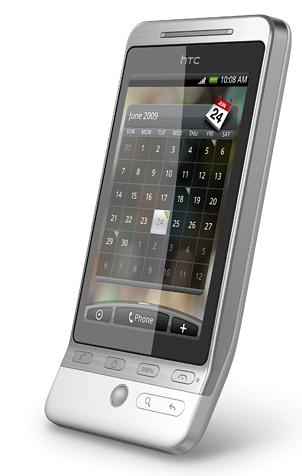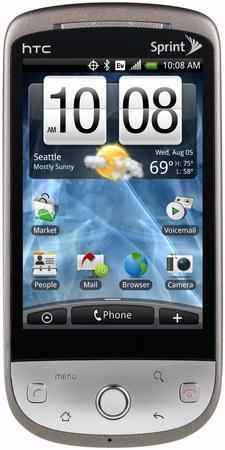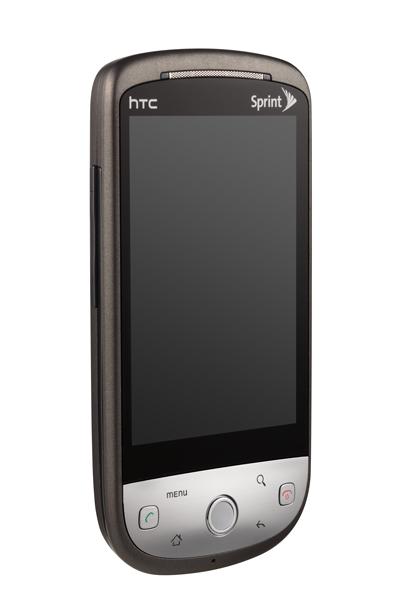What's good: Killer virtual keyboard; Sense UI is inviting and full of wow; gorgeous 3.2", 320 X 480 display with oleophobic coating; design is sophisticated but makes a statement; 3.5mm headphone jack; 5MP cam; Teflon on select colors; Hero represents a new day for Android.
What's bad: You need to go without the Sense extras for a snappy experience; my browsing experience on EDGE was very slow (issue for running on unsupported carriers); video camera isn't even worth using; some people hate the chin and asymmetrical button layout.
As the first OEM to sell a phone running Android, HTC holds a unique position in the Android market. They are well aware of the operating system's strengths and weaknesses, technical ins and outs, and surely what the public has adored and despised in previous implementations.
Much as they have done with the unappetising surface of Windows Mobile, HTC remedied the blandness of the vanilla Android home screen by way of a new experience and (as much as I hate to say this) a philosophy, called Sense.
The most readily apparent aspect of Sense is the user interface, which is actually still called TouchFLO - as it has been on the company's WinMo devices. This may change, but you can test it at the time of this writing by installing a home replacement such as aHome or dxTop. After install, hit the home button and you'll find that the Rosie UI (as it was termed in early leaks) has now been branded TouchFLO.
Sense also integrates Android devices with the user's online life; pulling friend's images from Facebook and allowing the aggregation of multiple data streams under one contact. For example, Jim may send you two emails from two different accounts. They may even be sent to two different accounts that you have set up on your Sense-equipped phone. When you look at Jim's contact entry, you'll see two or more new messages: the two emails, and his latest Tweet or Facebook update. Pretty cool stuff. (cont.)

In terms of beauty and style, HTC has a reputation for bold and sleek design. The Hero is no exception. However, as HTC's CIO admits, the Hero aesthetic is polarizing. People love it or hate it. There isn't much of a grey area. This is largely due to the phone's prominent chin, which juts out from the body of the device at a fifteen-degree trajectory.
If you ask me - and you are if you're reading this - the chin just fits. It feels and looks natural when held against the face, and there's something about it that gives Hero an air of future-retro chic. Yes, that is a real phrase. I just used it. The dark black/brown model I was sent is gorgeous.
In order to maintain sharp lines and a smooth surface, a sparse control layout leaves the phone without a dedicated camera button. In fact, beside the face control buttons; send, end, back, search, home, menu and trackball (action), the only hardware control element on the phone is the subdued volume rocker.
The lack of a camera button was not much of an issue for me until I tried to take a one-handed shot of myself and my wife. Those are always awkward, but trying to hit that scrolling action button and keep two heads in frame with no preview while ensuring the phone's safety is no easy task. This turned out to be less of an issue than I originally thought it would be, because I didn't have much use for the camera. I would count on Hero for shooting sights on vacation, but not for a birthday in a bar.
You'll get great, even stunning, still shots in bright light. But without a flash, dim situations are grim. And the camcorder is just plain bad. I'm hoping an update will resolve the horrible maximum resolution of 352 x 288 for video. Seriously, that department is hurting. I can optimistically report that the positive side to having a mediocre camera is that I'm not draining the battery unnecessarily.
Other aspects of Hero are just what they should be. You get a 3.5mm headphone jack, a sweet virtual keyboard (which is, to me, the greatest concern for a touch screen without a hardware QWERTY), a lovely interface, useful and beautiful widgets, and a bold body. What am I missing here? Ah, yes. The processor. (See next section)

I think I'm the only reviewer who doesn't have a serious gripe with Hero's 288 RAM, 512 ROM, and 528 MHz processor. I've seen a video where one reviewer loaded up some power-hungry widgets on Hero and then complained that the G1, running no widgets, is faster. I admit that the lovingly designed widgets are tempting, but their simultaneous availability does not mean they all must be run at once.
If you push Hero with widgets and background apps (which I admit, Sense is begging you to do), you're going to experience lag. I ran it very lean. This means that I missed out on some of the features that are achieving so much buzz for the device. In the near future, I think you will be able to run your Twitter widget and app, music player, and browse a website with Flash on an HTC Sense device - getting in return a snappy response. But right now, it's not happening. That may appear to be the phone HTC is selling, but it's not the phone you're buying. Caviat emptor. What's the Latin phrase for, "But it still kicks ass?"
HTC would have to be out of their collective mind to *not* push the widgets in terms of PR, but in a way I think this has set people up with unreasonable expectations - like they can run all of the widgets at the same time while going about their business of making phone calls and surfing the web. Many reviewers have been dissatisfied with a less-than-stellar experience rather than pleased by the wide variety of new functionalities HTC has bestowed on Android. They praise the battery and curse the processor. I, however, found the processor sufficient and the battery lacking - despite my minimal use of add-ons.
I personally like to keep my phone running light - using only what I need, which isn't much: phone, texts, maps, and a little bit of social app interaction. In turn, I had a very pleasant experience with Hero. When I put the words Hero and experience together in the same sentence, the first thing that pops into my mind is that fantastic keyboard. I would love to see it for sale in the Market.
I am as excited about the Hero as I was about the G1 at launch. I think this phone represents something big. I think it signals a sea change in the way people use their phones, and a major bump for the Android's profile in the eyes of the average consumer. But I went into my time with Hero recognizing that early adopters pay a price for the opportunity to taste features before they hit the mainstream. I didn't expect to run all of those lovely widgets at once without a slow, so I wasn't disappointed.
I also give this glowing review as an Android enthusiast counting on HTC to optimize the Hero ROM and extend battery life. All of us reviewers are talking and writing about an early preview, after all. We were told that Hero would hit the States by the end of the 2009. A push-back or two would not surprize me. So when you search for a Hero review and find results unfavorable to the Hero team, remember that the phone that the reviewer held is not the same one you'll eventually find in an American store. I have no stake in seeing HTC succeed. I just think think (and hope) they're being underestimated at this early stage in the life of a ground-breaking device.
What's good: same beautiful display found on G1 and myTouch; optimized version of HTC's Sense improves performance over earlier version; possibly the best virtual keyboard design currently available (though it will require more powerful hardware to surpass iPhone keyboard performance); 5 MP cam with elegant custom interface; 3.5mm audio jack (!!!); brilliant use of the Android notification system; ability to save homescreen profiles as Scenes; killer widgets; comes bundled with cool apps from Sprint like SprintTV and Visual Voicemail; Flash Lite support.
What's bad: RAM/processor duo are a bit tired in tomorrow's market, though not as bad as many claim; keyboard performance seems to break down long before other apps show signs of distress, and the keyboard should be prioritized; ability to multi-task and load the homescreens with all sorts of customizations can bring Hero to its knees, and the possibilities are incredibly tempting; music player behavior is a bit unpredictable under heavy use; browser functions best when extra options are disabled.
This is the first Sense device to hit the States, and it is most certainly a sensation. However, with Blur around the corner and Canvas not far behind, the novelty of a customized version of Android has worn off. Without the ground-breaking hype surrounding the GSM Hero, the weaknesses are more apparent than ever. This is, essentially, the same device I reviewed at the end of July, but because it's basically Sense prototype: the sequel, it doesn't carry the same flash or weight in my mind. So I'm a bit more critical of this one. Take that as you will. I was willing to forgo the luxury of 4 widgets with 6 apps running in the background in order to get the very best from the GSM Hero. Some called bias, others called foul. This time around, I've taken a more realistic approach. People want to compare Hero to the iPhone, only under drastically asymmetrical conditions; they expect the Hero to run 4 widgets and 6 programs in the background. So this was my standard for testing. (cont.)

The updated Hero looks has a more modern, discrete sensibility than the European Hero with its big chin and sharp lines. Four of the front panel buttons are hidden beneath a metal shield, which gives around each button so it can be pressed down; they are not touch-sensitive as many had hoped. All six of the face buttons light up, as does the large, somewhat loose, trackball. At the top of the face, on either side of the speaker, you'll find dual LEDs - each capable of several colors and assigned to various notifications.
One the left side of the phone is a volume rocker, and that's it for external controls. The top features a 3.5mm audio jack and the bottom, a miniUSB port. Speaker screening surrounds the 5.0 MP camera's lense hole on the back cover, which must be removed to swap out the microSD card, though the battery can stay in.
The 3.2" 320 x 480 TFT capacitive touchscreen is the same under the surface as seen in every other HTC Android so far, save the forthcoming Tattoo. It is sensitive and responsive, though not quite at the level (or size) of the iPhone's. What differentiates this screen is the oleophobic coating, which makes it fingerprint resistant and very easy to clean. Those coming from another touch screen will need to adapt to the surface, which is just a bit sticky for clean hands. Once a bit of those natural oils get on it the screen is smooth and a pleasure to touch.
Sense is Sense. If you haven't seen it in action, do yourself a favor and watch some videos on YouTube. HTC's customized version of Android provides fantastic widgets, social network implementation that is quite functional, and the ability to save Scenes; a profile bundle of preferences and settings. HTC has a customized Twitter app called Peep, a built-in Facebook client, and a revamped mail program. All are designed to fit in with the Sense navigation and theming, and all are friendly to the eye. The weather app is particularly attractive.
The camera interface and browser also underwent an HTC makeover, and while this camera wins over the Android default by leaps and bounds, the browser seems to have suffered; despite (possibly because of) the unanimously cheered implementation of Flash Lite. (cont.)

For those who like widgets and multi-tasking, Hero's browser is downright sluggish at times. Using it with the out-of-the box settings configuration was frustrating. It was better after a factory reset of this demo unit, but still a bit rough. Then I turned off Flash, javascript, and all other plugins. I changed the homepage. I was left with a lean, mean, real website surfin' machine. Even the keyboard performed fairly well under these circumstances. But I said I would approach this review with the expectations of the average consumer, and to be fair, they expect what they see in the hype. That said, the browser will turn off many, many users. Sprint has all plugs enabled and their PowerDeck set as the default homepage. It checks login information, grabs your location... by the time that page loads, you'll be wondering if the phone is frozen.
The differences between CDMA Hero and GSM Hero, in terms of the internal workings, are practically nil for the average user. Of course this phone works on Sprint's CDMA network, and the battery has been beefed up, but in terms of performance, the Stateside Hero is the same as its European counterpart. HTC has worked hard to deliver the promise of Sense in as robust a fashion as possible without sacrificing too much bling. The end result is that the lovely and intricate animations that defined Sense to hoards of gadget hounds are gone. The flip clock no longer flips; its weather icons are static. The homescreen can now be swiped from panel to panel without lag, even when you are running a bunch of apps. But performance issues pop up at other unfortunate times.
The top complaint I'm hearing from users (after the browser) is a laggy keyboard. HTC has found a way to keep most apps alive and functioning during times of stress, but that keyboard, where instant response is of chief importance, has a problem. I run light so it only bothers me while browsing, but for the average user running Hero for all it's worth, the keyboard just isn't fast enough.
As for calls, texting, emails, calendar use, bluetooth, etc., I have no complaints specific to those activities. The phonje performed well. The music player suffered from lack of power, but that has been covered. I wish the phone could play DRM'ed iTunes files, but what ca you do? Someone else is to blame for that.
I, along with most of you, am anxiously awaiting a Sense device with a 1 GHz+ processor and huge memory banks. When one does come out, people will wonder why I rated the Hero so high. But this is what we have right now. It the current market, I think Hero performance is acceptable, if only when weighed against the incredible advances Sense offers. If there were a Snapdragon Sense phone on the market today, I'd say sell your Hero (though it just might become the new hacker's toy, in place of the T-Mobile G1). Should you buy it? I can't tell you that. I could say that you shouldn't buy a computer for five more years because they'll be so much faster then. It's the perpetual geek dilemma of obsolescence and cost vs. worth. How soon do you neeed Sense?